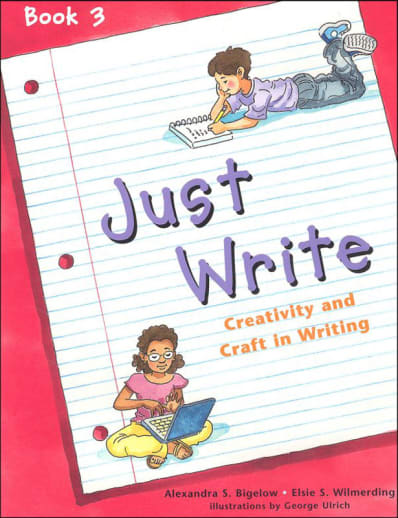Just Write Book 3 takes students through the four writing styles necessary to not only complete the writing done in school, but also the writing done throughout life - narrative, descriptive, expository, and persuasive. With examples and models to help students understand concepts and planning and revision-oriented exercises forming a methodical approach to writing, some of the topics/skills introduced to students are: single- and multi-paragraph organization, paragraph transitions, sequence and chronological order, word choice, establishing audience and purpose, fact and opinion, and more. This book has some review of the skills taught in books 1 and 2, though almost all of it is new material for the series. Includes a glossary of literary terms.
Just Write Book 3
Description
Just Write focuses on story writing and teaches many of the elements and strategies of writing to beginners. It’s a great program for teaching younger children to write and increase their success and pride in writing. Too often at this age students are given assignments to write stories or narratives with very little preparation or specific advice on how to accomplish this. This course is an effective method for teaching younger children to write, especially since there are not many programs that exist for this grade level.
Book 1 begins with planning a story and learning about story elements. It focuses on pre-writing activities, processes involved in writing the story, capitalization, basic punctuation, using one’s senses to create more vivid writing, exploring the paragraph, expanding sentences, being selective with words, editing, choosing a title, and publishing. These chapters vary in length and include definitions of concepts, models, and interesting exercises for student practice.
Book 2 has a slightly different format. It begins with some basic sentence, paragraph, and word skills, then proceeds to composing a story.
Book 3 takes students through the four writing styles necessary in school and in life.
The Teacher’s Guides provide specific teaching instructions, additional resource suggestions, an answer key, and some blackline masters.
| Product Format: | Softcover Book |
|---|---|
| Grades: | 4-6 |
| Brand: | Educators Publishing Service |
| ISBN: | 9780838826294 |
| Length in Inches: | 11 |
| Width in Inches: | 8.3125 |
| Height in Inches: | 0.25 |
| Weight in Pounds: | 0.45 |
| Edition: | Student Manual |
| Publication Date: | 1/4/2013 |

